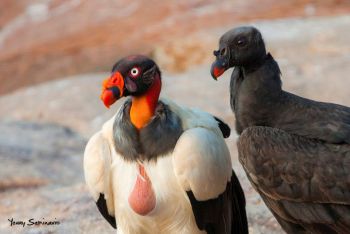- Sarcoramphus papa
Identification
Length: 71-81 cm(28-32")
Adult: plumage is extensively white with black flight and tail feathers. Head is orange, brown, and red, legs are gray, and eyes are white.
Juvenile: plumage dark gray to black (notice absence of shiny to white areas in the underside of the wing), but notice the white eye.
Similar species
Wood Stork has long neck and legs. Juvenile may be confused with other dark Vultures from the Americas which usually have dark eyes and pale areas in their underwings.
Distribution
Central and South America. Breeds in southern Mexico from the Isthmus of Tehuantepec, Chiapas and the lower Yucatan Peninsula, rarely recorded in Sinaloa, Puebla and Veracruz. Occurs south through Central America and in South America from Colombia, Venezuela and Trinidad south to south-west Peru, Bolivia, Paraguay, Uruguay and northern Argentina.
Taxonomy
This is a monotypic species[1].
Habitat
Lowland mature forest, often hunting over adjacent grasslands and along rivers.
Behaviour
Breeding
No actual nest. A single rough-shelled white egg is laid in the hollow of a tree stump or at the base of a spiny palm, or in a crevice in a cliff. Both sexes incubate for 50-58 days. The chick fledges at 130 days after hatching.
Diet
Strictly carrion, mostly medium-sized or larger mammals, but also on large fish, snakes, or birds.
Vocalisations
Guttural grunts and whistling hisses in courtship; also low croaks and bill-snapping.
References
- Clements, J. F., T. S. Schulenberg, M. J. Iliff, D. Roberson, T. A. Fredericks, B. L. Sullivan, and C. L. Wood. 2018. The eBird/Clements checklist of birds of the world: v2018. Downloaded from http://www.birds.cornell.edu/clementschecklist/download/
- Holste, M., J. M. Ruth, and J. C. Eitniear (2014). King Vulture (Sarcoramphus papa), version 1.0. In Neotropical Birds Online (T. S. Schulenberg, Editor). Cornell Lab of Ornithology, Ithaca, NY, USA. https://doi.org/10.2173/nb.kinvul1.01
- Houston, D., Kirwan, G.M. & Marks, J.S. (2019). King Vulture (Sarcoramphus papa). In: del Hoyo, J., Elliott, A., Sargatal, J., Christie, D.A. & de Juana, E. (eds.). Handbook of the Birds of the World Alive. Lynx Edicions, Barcelona. (retrieved from https://www.hbw.com/node/52944 on 2 January 2019).
- Global Raptor Information Network. 2019. Species account: King Vulture Sarcoramphus papa. Downloaded from http://www.globalraptors.org on 2 Jan. 2019
Recommended Citation
- BirdForum Opus contributors. (2025) King Vulture. In: BirdForum, the forum for wild birds and birding. Retrieved 12 May 2025 from https://www.birdforum.net/opus/King_Vulture
External Links
GSearch checked for 2020 platform.1







